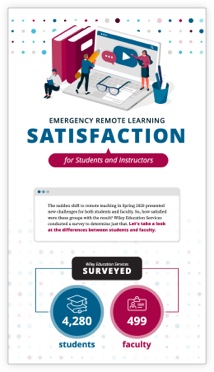Our recent survey sought to define undergraduate learners by studying their motivations, triggers, traits, and behaviors. Wiley found that most undergraduate students pursue a degree for four distinct reasons. By learning about these traits, your university can improve its marketing and enrollment strategies.
Click the image below to view the full infographic.
Enjoying this infographic? Fill out our quick two-step form to stay up-to-date with our latest reports and infographics.

The Strivers
Strivers believe that earning a degree is necessary to achieve their future goals. They realize that they need to learn new skills or reskill to advance.
44% of all undergraduate students
Key Goals: Attain a balance of professional achievement and personal fulfillment
Top Motivations: Explore new opportunities and achieve their goals
Barriers: Concerned about application logistics and staying focused on coursework
Wants: Would like 100% online, in-state for lower tuition, and a well-known brand
Demographic: Age mid-30s to mid-40s and diverse in gender
Common Degrees: No degree stands out–Strivers run the gamut
The Seekers
Seekers are interested in helping others and are less motivated by salary or promotions. Many are retired or unemployed and are not looking for work.
18% of all undergraduate students
Key Goals: Tailor studies to their exact interests, and provide programs that fit their lifestyle
Top Motivations: Fulfill a personal achievement
Barriers: Cost
Wants: Would like a specific online program at a reasonable cost that accommodates their interests
Demographic: Age 45+ and primarily female
Common Degrees: Seekers often pursue Health and Human Services and Psychology degrees
The Upgraders
Upgraders need to level up their education to a bachelor’s degree so they can attract better employment opportunities. These students are most likely to pursue a graduate degree or a professional certification after obtaining a bachelor’s degree.
15% of all undergraduate students
Key Goals: Improve their career prospects and expand their job options
Top Motivations: Need education options that are flexible and efficient
Barriers: Concerned about school and life balance
Wants: Would like ease, convenience, and the ability to transfer credits so they can graduate quickly
Demographic: Age <30 and primarily female
Common Degrees: Upgraders often pursue nursing degrees
The Questioners
Questioners are skeptical that college is worth the effort and wonder if a degree program will make a difference for them. They have moderate income and are less motivated by personal interest or passion.
23% of all undergraduate students
Key Goals: They vary across the group, but have shown less of a demand for tailoring their studies than the other segments
Top Motivations: Would like to fit in with peers getting their degrees
Barriers: If their educational journey gets disrupted, it tends to take them longer to finish
Wants: Would like an accredited, reputable, and well-known brand
Demographic: Age <30 and primarily male
Common Degrees: Questioners are often undecided
Understand students’ perspectives to anticipate and meet their needs.
By understanding the unique needs, motivations, and challenges of your prospective undergraduate students, you can provide more personalized engagement opportunities.
Coming Soon!
Watch for our upcoming Undergraduate Student Segmentation Report for more insights. In the meantime, visit our blog to read our latest reports and find more resources on trends in higher ed.


















